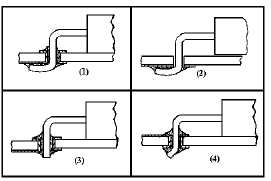16
Figure 2B.
Solder joints.
IN ANSWERING QUESTION 2-36, REFER TO
FIGURE 2B.
2-36. All the solder joints in the figure have two
things in common. The first is that all are
through-the-board terminations. The
other is that they are all what type of joint?
1. Sweat
2. Full-fillet
3. Unacceptable
4. Clinched-lead
2-37. Plug-in DIPs are mounted by using which
of the following aids/parts?
1. Insulators
2. Special tools
3. Clinched leads
4. Mounting sockets
2-38. Plug-in DIPs are susceptible to loosening
because of which of the following causes?
1. Heat
2. Stress
3. Warpage
4. Vibration
2-39. Component leads may be clipped to aid in
their removal under which of the following
conditions?
1. When the component is conformally
coated
2. When the component is known to be
defective
3. When board damage may result from
normal removal methods
4. Both 2 and 3 above
2-40. Visual inspection of a completed repair is
conducted to evaluate which of the
following aspects of the repair?
1. Workmanship quality
2. Component placement
3. In-circuit quality test
4. Conformal coating integrity
2-41. When speaking of TO mounting
techniques, the term "plug-in" refers to the
same technique as is used with DIPs.
1. True
2. False
2-42. In addition to heat dissipation and physical
support, which of the following needs
might justify the use of a spacer with a TO
mount?
1. Vibration elimination
2. Proper lead formation
3. Proper lead termination
4. Short-circuit protection
2-43. For the removal of imbedded TOs in
which all the leads are free, which of the
following methods is recommended?
1. Push out gently
2. Pull out with pliers
3. Pull out with fingers
4. Tap out with soft mallet


